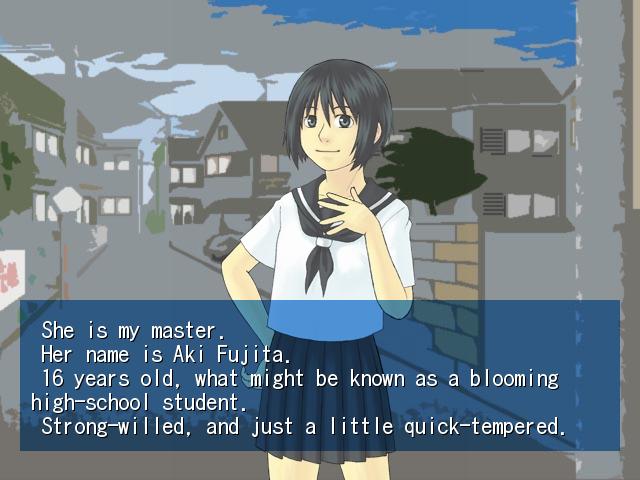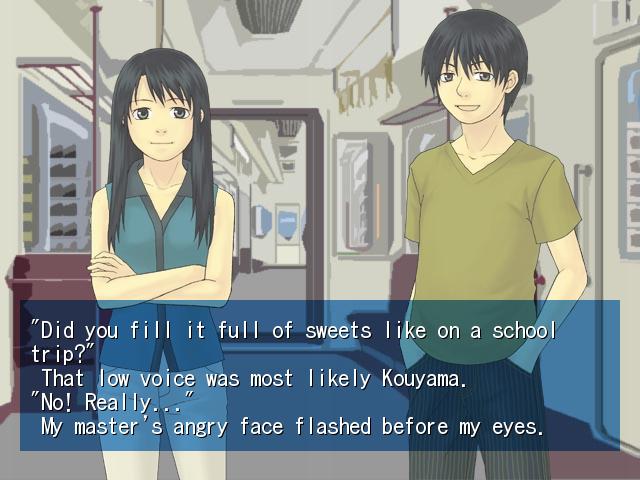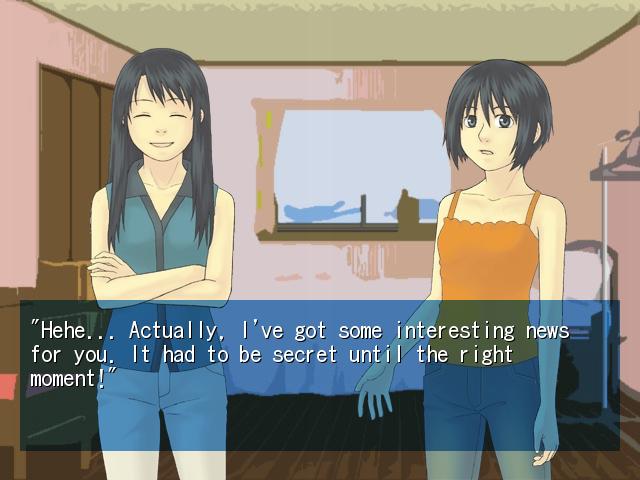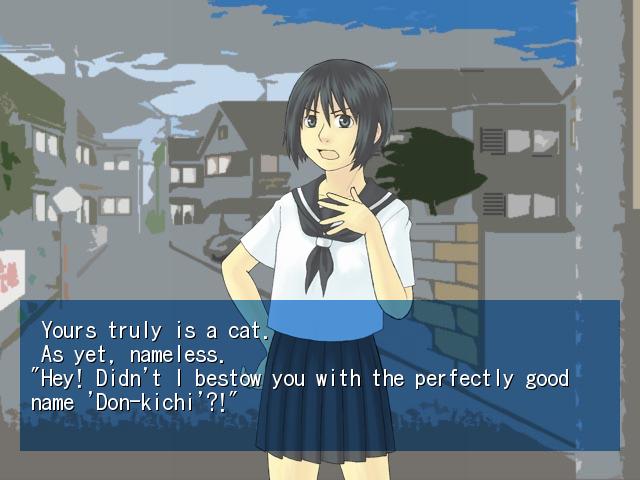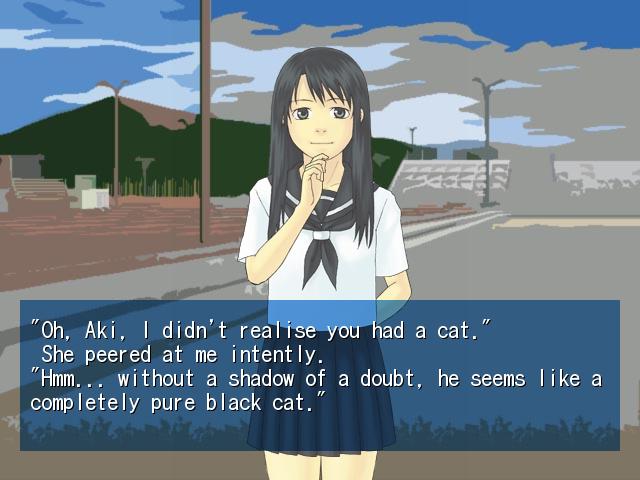My Black Cat is the 2006 official English-language translation of a 2005 freeware Japanese visual novel titled Watashi no Kuroneko. The English translation was completed by Ben Carter and submitted to the al|together 2006 visual novel translation festival. The original Japanese novel was created by Natukusa. Below, I review My Black Cat as part of my project to cover nearly all of the 31 Japanese freeware visual novels translations submitted to the 2005, 2006, and 2008 al|together festivals.
You can learn more about my al|together project by reading my project introduction article. That article includes a running list of our completed al|together reviews. I have a dedicated collection post with links to all of our al|together articles, including reviews, essays, and short posts.
(Before continuing to the review, I note that this is my 29th and final visual novel review of my al|together project. While there were 31 novels, I omitted two from the full review list because this is a family website, although I will give both of those novels short-reviews in my final al|together assessment article.)
My Black Cat is unique in that it is the only one of the 31 al|together visual novels to be principally narrated by a cat (it is not the only one to at any time be narrated by a cat). The player sees events through the eyes of Don-kichi the black cat, who regularly converses with his master, Aki Fujita. As the novel develops, it becomes evident that there may be some significance to Don-kichi’s ability to talk and Aki’s being the only human who can understand Don-kichi’s words.
My Black Cat Details
2006 English version
| Title | My Black Cat |
| Translator | Ben Carter (website) |
| Release Date | August 20, 2006 |
| Engine | ONScripter |
| Official Website | al|together 2006 |
2005 Japanese release
| Title | Watashi no Kuroneko |
| Creator | Natukusa |
| Release Date | February 25, 2005 |
| Engine | NSCripter |
The official website for the Japanese game is down and there is no archived version available.
Downloading and Installing My Black Cat
My Black Cat can be downloaded from a mirror of the al|together site or from Kaisernet’s ONScripter games list. Note that the MacOS downloads will most likely not run on modern versions of MacOS.
I had a few technical issues with My Black Cat. Firstly, from the outset, I was unable to install the Windows version on top of WINE – but because I planned to run it natively on Linux, I did not dig too far into the issue. See my guide to running ONScripter-EN games on Linux.
I ultimately ran My Black Cat with an old 2011 Linux ONScripter-EN build instead of the currently maintained ONScripter-EN project because, as of the 6.28.23 ONScripter-EN release, no sound played on my particular system. I would encourage Linux users (and Windows users) to try the new builds of ONScripter-EN before resorting to my version.
My sound issues derived in part from the fact that My Black Cat uses MIDI for music. I discussed how I got MIDI sound in al|together novels working in most cases on my Arch Linux-based system. Sound generally worked with the 2011 Linux ONScripter-EN build with the exception of two scenes where the music did not play. Outside of those two scenes, everything worked as expected save for being unable to save on choices – which is a technical issue that affects several of the al|together novels.
My Black Cat Overview
My Black Cat puts the player in the head of Don-kichi, a black cat who had been recently adopted by a high school girl named Aki Fujita. For some unknown reason, Aki can understand Don-kichi and Don-kichi can understand Aki, but it appears that no one else is aware that the player – here being a black cat – can communicate with human beings.
Other than the talking black cat, My Black Cat is set in what appears to be an ordinary town in modern Japan with ordinary people. The novel introduces a few of Aki’s classmates.
Early in the fairly short story, we learn that Aki is haunted by the fact that one of her best friends is in a coma. As Don-kichi, the player can decide how to respond to Aki’s sad story and what actions to undertake at certain junctures.
My Black Cat Review
Below, I review My Black Cat in several parts.
Estimated reading time
The translator of the novel, Mr. Ben Carter, estimated that My Black Cat contains about one hour of reading. Visual Novel Database gives the novel a 35-minute estimate based on three votes. I think that the Visual Novel Database estimate is much closer to the mark, and a relatively quick reader who makes good use of skipping and can also figure out how the choice structure works can likely see everything My Black Cat has to offer, namely its three endings, in less than the 35-minute aggregate estimate on Visual Novel Database.
Game-play and structure
My Black Cat features seven in-game choices – which is a large number given that My Black Cat is on the short side. Some, but not all of the choices, have point values attached to them. The number of points the player has determines which of the three endings the player sees. As we will discuss later, My Black Cat’s central mechanic is its three endings and how the endings relate to one another. Completing the endings unlocks three short afterwords wherein the author explains his thinking behind each of the endings.

Exempting the peculiar Crimsoness and OMGFTOL, My Black Cat is only clearly surpassed by Night of the Forget-Me-Nots for the title of most interactive traditional visual/sound novel in al|together.
Visual presentation
My Black Cat is one of the most visually distinctive efforts of al|together, featuring sprites for all of its speaking characters (along with a surprising number of outfits given its small number of scenes) and fully painted backgrounds (a distinct simple computer raster art aesthetic).
The author went for a more realistic aesthetic for the characters, giving everyone round faces, distinct noses, and relatively small (for the genre) eyes.
Just about all of the other al|together novels go for a more anime look for lack of a better term. While the characters in My Black Cat are simple and there is a bit of same face syndrome, I found their designs to be refreshing and appreciated that the author went for something a little bit different than the standard.
I also liked the backgrounds – they remind me a bit of Flood of Tears but are a bit cleaner. The backgrounds are clearly closely tied to real photographs – see for example the train below – but the author gave them some nice painted flourishes. The outdoor backgrounds could make charming desktop backgrounds (I was reminded of some of the newer Fedora-GNOME desktop backgrounds).
While My Black Cat has an interesting visual aesthetic for characters and backgrounds, its user interface is more conventional. It comes with stock NScripter menus and a simple text box. For whatever it is worth, while the text box lacks some of the interesting design elements we saw in higher production value al|together novels, I do think the author made the right call in confining text to a text box instead of having it run from the top of the screen to the bottom.
Music and sound effects
I cannot give a full review of the background music in My Black Cat since at least one (and possibly two) tracks did not play. The music that did work was decent enough for background music, but it lacks any stand-out tracks. I found that the sudden onset of music in the novel’s second scene after being generally static was a bit jarring – but other than that My Black Cat is one of the lower profile audio productions of al|together.
Translation analysis
As always, I preface this section by noting that I do not read Japanese and have obviously not read the original Japanese novel (which may not be available in the case of My Black Cat). My review is solely of how the translation reads in English.
My Black Cat reads well from start to finish, and the translator, Ben Carter, did an effective job of giving our feline narrator a distinct voice and sense of humor.
The translation captures the nuance of each of My Black Cat’s three endings and also provides a translation of the author’s explanation of the endings that reads clearly and is consistent with an ordinary reading of the endings themselves.
I picked up two interesting translation notes.
Firstly, Mr. Carter used British English instead of U.S. English, much like Peter “Haeleth” Jolly in his version of Narcissu. It is less prominent in My Black Cat than in Narcissu, but I noted realise instead of realize in one instance. Again – this is an observation, not a complaint.
There is a comical choice early in the novel wherein the translator opted to keep two Japanese names, one of which should be familiar to New Leaf Journal readers (pictured in game structure section).
I noted this one because different translators in al|together had different views on how to handle references to Japanese history or popular culture. See, for example, my translation notes for Flood of Tears.
Writing and story quality
I am more constrained in discussing the story of My Black Cat than I am with most al|together novels, both because it is short and because its central gimmick has to do with its three endings.
My Black Cat is an economical novel. It wastes no time in introducing Aki and Don-kichi and establishing their relationship before using the introduction of a third character to introduce Aki’s central conflict– her friend being in a coma.
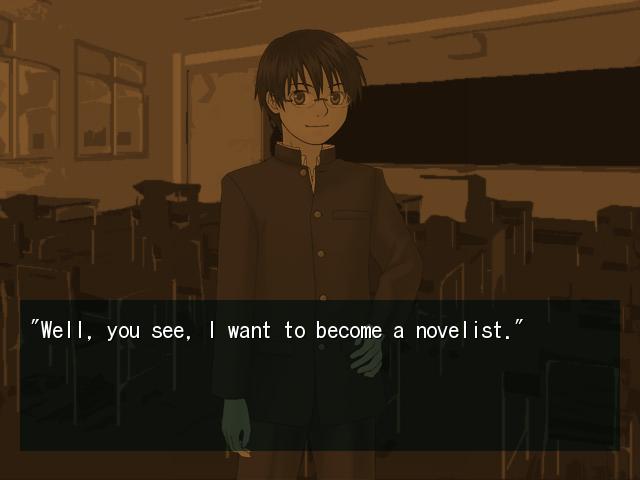
Most of the meaningful choices concern how the player, as Don-kichi the cat, interacts with Aki with respect to this conflict . As one may suspect, Don-kichi’s choices ultimately decide which of the three endings occur.
In order for My Black Cat to work, the choices have to make sense in how they lead the player to one of the three endings. On one hand, once I reached the first ending, I had no difficulty finding the second and third endings by making slightly different choices on my next two tries. However, I do not think the precise way the choices function is entirely intuitive from just reading My Black Cat without first studying the novel’s 0.txt file, which contains all of the game information. But even given that I found it easy to reach all three endings after completing the first with the choices I wanted to make in my first reading is a credit to the author.
My Black Cat benefits from being focused, engaging in how it presents choices, and making the brief conversations between Don-kichi and Aki reasonably fun. As a completed piece, however, it suffers from an affliction that some of its al|together peers have: My Black Cat feels like it was written to deliver a structural idea – here being three variations on its ending – more than it feels like a comprehensive story. While I appreciate the sentiments behind the endings, the story was not long or detailed enough to deliver the emotional punch of any of the endings (albeit the issue was less significant here than in some other similarly afflicted al|together pieces). We do not know Don-kichi, Aki, or the rest of the cast much better at the end of the story than we do at the beginning. While giving the player choices builds some investment, My Black Cat’s mechanic is not as engaging as what we saw complement the similarly simple (and even shorter) story in Summer, Cicadas, and the Girl.
Technical points
Completing My Black Cat unlocks the author’s commentary on the endings. Each commentary is brief but I enjoyed them because they give a clear picture of the author’s thinking in crafting My Black Cat and the author’s commentary informed my own analysis of the piece.
Like (almost) all of the al|together novels, My Black Cat comes with a fair number of save slots. However, although it is impossible to save when the options appear,
in because My Black Cat is very short, the saves are ultimately meaningless. Fortunately, the skip functionality works well so it is possible to jump from choice to choice to try different combinations – both to see all of the novel’s dialogue and to reach the three endings without having to re-read previously-seen dialogue.
Conclusion
While My Black Cat’s lack of ambition prevents it from tangling with the best novel translations to come out of al|together, it is a fun, short, and memorable contribution to the corpus. It has a unique art style, unique protagonist, and an art style that both works and is not replicated in any of the other al|together pieces. Its gimmick surrounding the endings, which was admirably explained by the author, leaves readers with a bit more to think about than had the novel been purely kinetic. My Black Cat is worth reading for anyone who is interested in visual novels of the era and it is also a fair read for people who are not generally interested in novels in that it has a nice and simple story and provides a simple example of how choices can be used to distinguish visual novels from other media.

